The restaurant industry has evolved from walk-ins and printed menus to digital bookings and contactless dining. With smartphones shaping customer habits, restaurant apps are now a must-have. From browsing menus to booking tables, people want it all just a tap away.
Among these, restaurant reservation apps stand out. And when we think of reservations, OpenTable leads the way. It’s simple, smooth, and saves people from the hassle of long waits or phone calls.
This shift in dining behavior has prompted many food entrepreneurs and hospitality businesses to ask: “How much does it cost to develop an app like OpenTable?”
Here’s a quick answer: The average cost to build an app like OpenTable ranges from $25,000 to $100,000, depending on the features and complexity.
In this blog, we’ll break down everything, from key features and cost factors to money-making models and smart ways to save during development.
Overview of OpenTable’s Journey
In 1998, Chuck Templeton founded OpenTable after witnessing his wife's frustration with the cumbersome process of making restaurant reservations over the phone.
Recognizing the need for a more efficient system, Templeton launched OpenTable in San Francisco, starting with a limited selection of restaurants. The platform introduced a real-time reservation system, allowing users to book tables online and restaurants to manage reservations digitally.
Over the years, OpenTable expanded its services, covering more than 55,000 restaurants in over 80 countries as of 2024.
The company went public in 2009 and was later acquired by Priceline Group (now Booking Holdings) in 2014 for $2.6 billion. Under the leadership of CEO Debby Soo, OpenTable has continued to innovate, offering features like mobile applications for diners and comprehensive reservation management systems for restaurants.
OpenTable's success has inspired many entrepreneurs and businesses to explore the development of similar restaurant reservation apps. Understanding the cost to build a restaurant app like OpenTable is crucial for those looking to enter this market. Factors influencing the cost include the complexity of features, design requirements, and integration capabilities.
Key Statistics:
-
- Group Dining Trend: Group dining has increased by 8% year-over-year, with notable spikes at 10 AM and 6 PM.
- Dining Demand: In the week ending January 6, 2025, seated diners in the U.S. were up 25% compared to the same week in 2024.
- Data Analytics: OpenTable provides restaurants with access to performance reports, helping them optimize operations and forecast revenue.
Over the years, OpenTable has grown from a simple reservation tool into a full-fledged restaurant management platform, making it a go-to solution for diners.
So, if you’re wondering what it takes to build a similar app, understanding the mobile app development cost involved is your next step.
Let’s break down the average cost to build a restaurant reservation app like OpenTable.
Average Cost To Build a Restaurant Reservation App Like OpenTable
If you’re a restaurant owner, entrepreneur, or startup looking to build an app like OpenTable, one of the first questions that comes to mind is, “how much does it cost to build an app like OpenTable?”
The average cost to build a restaurant reservation app like OpenTable typically ranges between $25,000 to $100,000 or more, depending on your goals, features, and development approach.
A basic version with core features like reservation scheduling, user login, restaurant listing, and notifications may cost around $30,000 to $50,000. But if you want an advanced solution with table mapping, AI-driven recommendations, customer loyalty programs, reviews, and POS integrations, the price can go upwards of $100,000 to $150,000+.
Other factors that affect the OpenTable-like app development cost include whether you're building for iOS, Android, or both, the complexity of the UI/UX design, real-time database integration, and third-party APIs.
To get a more tailored estimate based on your needs and location, it's best to consult the best mobile app development company, who specialize in building high-performing apps for the restaurant industry.
From features to design and platform choices, every detail can impact your budget.
Let’s explore the key factors affecting the cost to create an app like OpenTable in more detail.
Key Factors Affecting The Cost To Create an App Like OpenTable
If you're planning to build a restaurant reservation app like OpenTable, one of the first questions that’ll cross your mind is: “How much will it actually cost?” The truth is, there’s no one-size-fits-all answer.
The cost to create a restaurant app depends on a variety of elements, some technical, some design-related, and others purely strategic.
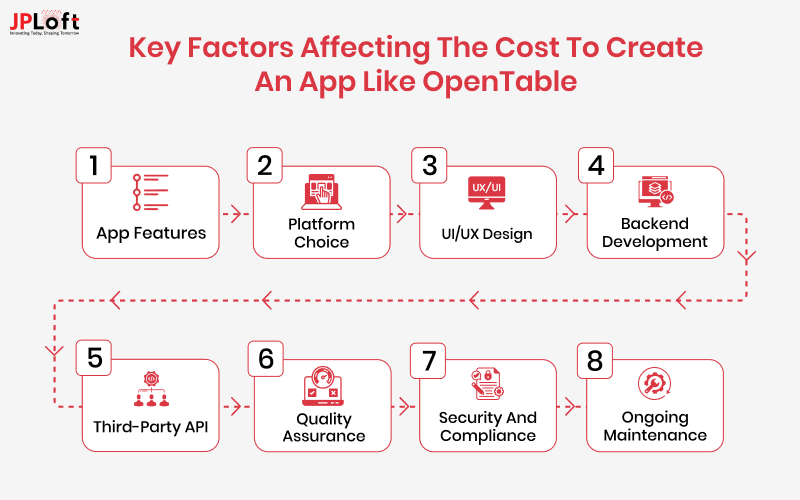
Let’s break it down in simple terms so you know where your money is going when investing in OpenTable-like app development.
1. App Features and Functionalities
The more features you add, the more complex and costly the app becomes. Basic features like table reservations, search filters, restaurant profiles, and user accounts are essential.
But adding advanced functionalities like real-time availability, AI-powered recommendations, loyalty programs, reviews & ratings, or multi-language support can significantly increase the cost to build an app like OpenTable.
If you’re planning to offer a premium user experience with robust features, expect a higher price tag especially when custom coding is required.
|
Feature |
Description |
Average Cost (USD) |
|
User Registration & Login |
Allows users to sign up/login via email, phone, or social accounts |
$1,000 – $2,500 |
|
Restaurant Listings |
Displays restaurants with filters like cuisine, location, rating, etc. |
$2,000 – $4,000 |
|
Table Reservation System |
Lets users book tables with date, time, and number of people |
$3,000 – $5,000 |
|
Restaurant Dashboard |
For restaurants to manage bookings, menus, offers, and availability |
$3,000 – $6,000 |
|
Search & Filter Options |
Allows users to filter restaurants by various parameters |
$1,500 – $3,000 |
|
AI-Powered Recommendations |
Suggests restaurants based on user behavior and preferences |
$4,000 – $7,000 |
|
Multi-language Support |
Enables users to switch app language as per their preference |
$1,500 – $3,000 |
2. Platform Choice: iOS, Android, or Both?
Choosing between iOS, Android, or launching a cross-platform app can affect your development budget.
Building a native app for just one platform is cheaper initially, but you'll limit your audience. A cross-platform app using frameworks like Flutter or React Native can save money while reaching both platforms.
However, if you want the best performance and UI/UX design, building separate native apps will increase the cost to develop a restaurant app like OpenTable.
|
Platform |
Description |
Estimated Cost (USD) |
|
iOS (Apple) |
Developing for iPhones and iPads using Swift or Objective-C. |
$15,000 – $35,000 |
|
Android |
Building for Android devices using Kotlin or Java. |
$10,000 – $30,000 |
|
Both (Cross-Platform) |
Using frameworks like Flutter or React Native to build for iOS & Android simultaneously. |
$25,000 – $50,000+ |
3. Design & User Experience (UI/UX)
A visually appealing, intuitive app isn’t just nice to have, it’s expected.
Clean layouts, simple navigation, and fast loading times all contribute to a positive user experience. Investing in a thoughtful UI/UX design will increase the overall cost to build a restaurant reservation app like OpenTable, but it also helps retain users and reduce app abandonment.
If you’re planning to build a restaurant app for targeting upscale restaurants or premium diners, this is a must-have area of investment.
|
Design Element |
Description |
Estimated Cost (USD) |
|
Basic layout or blueprint of the app to define structure and screen flow |
$1,000 – $2,500 |
|
|
UI Design |
Visual elements – colours, fonts, icons, images, layout |
$3,000 – $7,000 |
|
UX Design |
Focuses on how users interact with the app – flow, navigation, usability |
$2,500 – $6,000 |
|
Simulated version of the app to test design and functionality before development |
$2,000 – $4,000 |
|
|
Branding & Custom Graphics |
Logo, theme, custom illustrations tailored to the restaurant brand |
$1,000 – $3,000 |
4. Backend Development & Server Infrastructure
The backend is the backbone of the app, it manages bookings, user data, restaurant info, payments, and notifications.
A robust backend ensures your app works smoothly even with thousands of users and restaurants. To build a reliable backend, you’ll need developers who can handle database management, API integration, and cloud-based hosting.
All these technical components will increase the cost to create a restaurant reservation app like OpenTable but are critical for long-term performance and scalability.
|
Component |
Description |
Estimated Cost (USD) |
|
Database Management |
Stores user profiles, bookings, restaurant details, menus, reviews, etc. |
$2,000 – $5,000 |
|
Server Infrastructure |
Hosts the backend logic and APIs that run the app |
$1,500 – $6,000 (initial) |
|
API Development |
Enables communication between app frontend and backend |
$3,000 – $7,000 |
|
Admin Panel & Dashboard |
Lets restaurant owners manage reservations, menus, timings, and user data |
$2,500 – $6,000 |
|
Cloud Services Integration |
AWS, Google Cloud, or Azure – to enable secure, scalable app hosting |
$1,000 – $3,000 monthly (scalable) |
|
Security & Compliance Setup |
SSL, data encryption, and compliance with data protection laws |
$1,500 – $4,000 |
5. Third-party API Integrations
Top restaurant apps rely on third-party APIs for things like payment processing (Stripe, PayPal), location services (Google Maps), SMS/email notifications, and social logins.
These integrations come with licensing costs and require expert implementation. The more APIs your app uses, the higher the development complexity and cost.
But the good news? These integrations can make your app much more functional and user-friendly, just be sure to factor them into your budget.
|
Integration Type |
Description |
Estimated Cost (USD) |
|
Payment Gateways |
Integration with Stripe, PayPal, Square, etc. for secure and smooth in-app payments |
$2,000 – $5,000 |
|
Mapping & Geolocation APIs |
Google Maps or Mapbox to help users locate nearby restaurants and get directions |
$1,000 – $3,000 |
|
SMS & Email Notification APIs |
Twilio, SendGrid, etc. for sending booking confirmations, reminders, and promotions |
$1,500 – $4,000 |
|
Social Media Login APIs |
Allows users to sign in via Facebook, Google, Apple, etc. |
$1,000 – $2,500 |
|
Review & Rating Systems |
Enables users to leave ratings and reviews for restaurants and services |
$1,000 – $3,000 |
|
Calendar Sync APIs |
Sync with Google or Apple calendars to update reservations automatically |
$1,500 – $3,500 |
|
Restaurant POS Integration |
Connects with POS systems for order tracking, billing, and availability updates |
$2,000 – $6,000 |
6. App Testing & Quality Assurance (QA)
Before launching your app to the public, it’s essential to ensure it’s bug-free, user-friendly, and secure. This is where comprehensive app testing and QA come in. Testing includes functional testing, usability testing, performance testing, device compatibility checks, and security testing.
From ensuring smooth table booking flows to making sure the app doesn’t crash under load, QA teams test every feature from a real user’s perspective. It also helps identify bugs early, saving you from costly fixes after launch.
The more complex the app, the more rigorous the testing required which directly affects the overall cost to build an app like OpenTable. Skipping thorough testing can damage user trust and your brand reputation in the long run.
|
Aspect |
Description |
Average Cost |
|
Functional Testing |
Checks if all features work as intended across different devices and platforms. |
$2,000 – $5,000 |
|
Usability Testing |
Ensures the app is user-friendly and intuitive, helping users complete tasks easily without confusion or frustration. |
$1,000 – $3,000 |
|
Performance Testing |
Verifies that the app runs smoothly under different network conditions and during high-traffic situations. |
$1,500 – $4,000 |
|
Compatibility Testing |
Confirms that the app works consistently across various devices, screen sizes, and operating systems (iOS, Android). |
$1,000 – $2,500 |
|
Security Testing |
Tests for vulnerabilities like data breaches, payment fraud, and unauthorized access to protect user and restaurant information. |
$2,000 – $4,000 |
|
Bug Fixing & Final QA Review |
Final check to catch remaining issues, fix bugs, and polish app performance before launch. |
$1,500 – $3,000 |
|
Total Estimated QA & Testing Cost |
Includes all testing processes required to ensure a reliable, scalable, and user-friendly OpenTable-like app. |
$9,000 – $18,500 |
7. Security and Compliance
With sensitive data like user profiles, payment details, and restaurant info involved, security isn’t optional.
You’ll need end-to-end encryption, GDPR compliance, secure payment gateways, and proper authentication systems. These features may seem like backend essentials, but they add to the overall cost to develop a restaurant reservation app like OpenTable.
Still, investing in app security measures protects your brand reputation and ensures long-term trust among users and businesses.
|
Security/Compliance Measure |
Description |
Estimated Cost (USD) |
|
Data Encryption (SSL/TLS) |
Encrypts sensitive user data during transmission to prevent unauthorized access |
$1,000 – $3,000 |
|
GDPR/CCPA Compliance |
Ensures user data handling follows global privacy regulations (especially important for US & EU markets) |
$2,000 – $4,000 |
|
Secure Authentication Systems |
Multi-factor authentication (MFA), biometric login, or one-time password (OTP) |
$1,500 – $3,000 |
|
Role-Based Access Control (RBAC) |
Allows different permissions for users, admins, and restaurant staff |
$1,000 – $2,500 |
|
PCI-DSS Compliance |
For apps that handle card payments directly, this ensures secure handling of cardholder data |
$2,500 – $5,000 |
|
Regular Security Audits |
Periodic assessments of code, APIs, and databases to detect and fix vulnerabilities |
$2,000 – $5,000 annually |
8. Ongoing Maintenance & Updates
Development doesn’t end with the app launch. You'll need to account for ongoing costs like bug fixes, feature updates, and OS compatibility upgrades.
As the restaurant industry evolves and user expectations change, so must your app. On average, yearly maintenance can be 15–20% of the original mobile app development cost. This is a crucial factor many entrepreneurs overlook when budgeting for their project.
|
Maintenance Component |
Description |
Estimated Annual Cost (USD) |
|
Bug Fixes & Issue Resolution |
Regular fixes for minor/major bugs reported by users or discovered through testing |
$2,000 – $5,000 |
|
Feature Enhancements |
Adding new features or refining existing ones based on user feedback and evolving needs |
$3,000 – $8,000 |
|
Platform & OS Updates |
Adapting the app to work seamlessly with new Android/iOS versions and device models |
$1,500 – $3,000 |
|
Server & Hosting Management |
Monitoring and maintaining server performance, uptime, storage, and backups |
$2,500 – $6,000 |
|
Security Patches & Compliance |
Regular updates to fix vulnerabilities and stay compliant with data privacy and payment regulations |
$2,000 – $4,000 |
|
Performance Optimization |
Continuous monitoring and improvements to app loading speed, responsiveness, and resource usage |
$1,500 – $3,500 |
|
User Support & Feedback Handling |
Managing user queries, complaints, and implementing suggestions |
$1,000 – $2,500 |
How Top Restaurant Apps Like OpenTable Make Money?
If you're planning to develop a restaurant app like OpenTable, it's important to understand how these apps make money.
After all, your investment in development should bring a strong return. Restaurant reservation apps like OpenTable follow different app business models that not only attract users but also generate steady revenue.

Let’s break down the most common revenue streams:
1] Commission from Restaurants
One of the primary ways apps like OpenTable earn money is by charging restaurants a fee for every booking made through the app.
This is a pay-per-use model. For example, when a user reserves a table, the restaurant pays a small commission. This model works well because restaurants only pay when they get a confirmed customer.
2] Subscription Plans for Restaurants
The best restaurant reservation app also offers premium monthly or yearly subscription plans for restaurants.
These plans often include advanced features like analytics, marketing tools, menu management, and customer feedback options. This recurring revenue model is great for ensuring a stable income stream for the app owners.
3] Featured Listings and Promotions
Restaurants can also pay to be listed at the top of search results or on the homepage of the app.
These paid placements and ads give more visibility to the restaurants and help app owners earn extra revenue. It's a win-win, as restaurants get more exposure and the app gets a financial boost.
4] User-side Premium Features
While most users access basic features for free, apps may offer in-app purchases or premium memberships. For instance, users might pay for early access to bookings at high-end restaurants or exclusive discounts.
5] Data & Insights for Businesses
Some platforms sell aggregated data and insights to restaurants and hospitality partners.
This helps them understand customer behavior, popular booking times, and preferred cuisines valuable data that businesses are willing to pay for.
If you want to build a profitable app like OpenTable, these monetization models are worth considering from the very beginning. Now, let’s see how you can cut short your expenses by following these cost optimization tips.
How Can You Optimize The OpenTable-Like App Development Cost?
Building a mobile app is a big investment but that doesn’t mean you have to go over budget.
With the right approach and planning, you can optimize the cost to develop a restaurant app while still delivering a high-quality product.
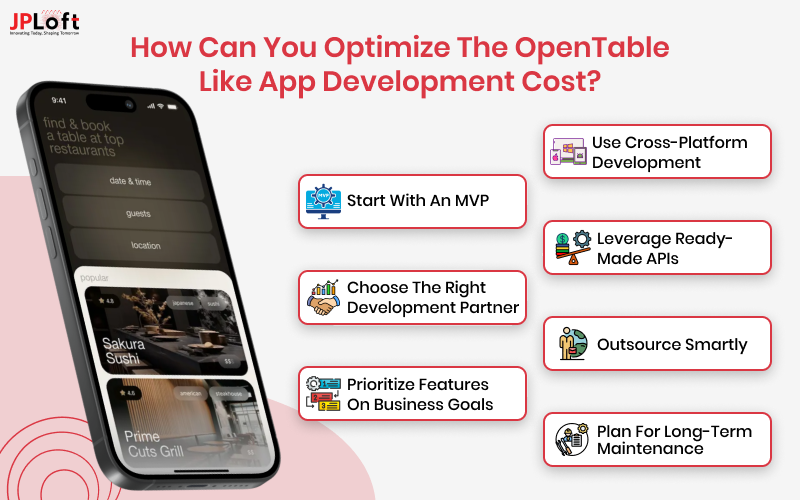
Whether you're a food entrepreneur, startup, or restaurant chain, here's how to keep costs under control without compromising on performance.
A] Start with an MVP (Minimum Viable Product)
Instead of building a full-featured app right away, begin with a MVP.
Focus on the core features like user registration, restaurant listing, table booking, and basic admin access. This helps you reduce the initial cost to build an app like OpenTable and test the market response. Once the app gains traction, you can scale and add more advanced functionalities.
B] Choose the Right Development Partner
Partnering with an experienced on-demand app development company can make a huge difference.
A good team will guide you through cost-effective strategies, help avoid technical errors, and use pre-built modules when possible, reducing your restaurant reservation app development cost significantly.
C] Prioritize Features Based on Business Goals
While it’s tempting to include every cool feature you’ve seen in other apps, not all features are necessary from day one.
Ask yourself: Will this feature help attract users or generate revenue? Prioritize features that support your business model and postpone the ones that don’t.
This approach helps control the cost to develop an app similar to OpenTable.
D] Use Cross-Platform Development
If you want your app to run on both iOS and Android, consider using cross-platform frameworks like Flutter or React Native.
These tools allow developers to write a single codebase for both platforms, reducing development time and effort and lowering the cost to create a restaurant app like OpenTable.
E] Leverage Ready-Made APIs
Instead of building everything from scratch, use third-party APIs for features like maps, payments, analytics, and login.
These integrations are faster and cheaper to implement, helping you save on the cost to develop a restaurant reservation app like OpenTable.
F] Outsource Smartly
Hiring in-house developers can be expensive, especially in the USA.
Outsourcing development to reliable offshore teams can drastically cut costs while still maintaining quality. This is one of the best ways to manage the Opentable clone app development cost efficiently.
G] Plan for Long-Term Maintenance
Ongoing maintenance cost is often overlooked but adds to the cost to build an app like OpenTable in the long run. Choose scalable tech stacks, document your code, and set aside a budget for regular updates. Preventing bugs and crashes early can save you from costly fixes later.
By following these tips, you’ll be able to develop an app like OpenTable that’s not just cost-effective but also future-ready.
Thoughtful planning, smart development choices, and the right tech partner can go a long way in bringing your restaurant app idea to life without breaking the bank.
Why Choose JPLoft for Your Restaurant App Development?
If you are planning to build a restaurant reservation app like OpenTable, partnering with the right development team can make all the difference.
At JPLoft, we specialize in creating high-performance, user-friendly, and scalable apps tailored to your business goals.
With over a decade of experience in mobile and web app development, our team understands what it takes to stand out in the competitive food-tech space.
From crafting intuitive UI/UX to integrating smart booking systems, payment gateways, and real-time analytics, we handle every aspect of your project with precision.
As a trusted restaurant app development company, we not only focus on technical execution but also provide strategic guidance to help you keep your OpenTable clone app development cost in control. Whether you're a startup, single restaurant, or an enterprise, we’ll help you bring your vision to life.
The Bottom Line
Building a restaurant reservation app like OpenTable is a smart move in today’s tech-driven food industry. With the growing demand for seamless dining experiences, such apps are not just a luxury, they’re a necessity.
From advanced features like AI-powered matching and real-time availability to secure payments and user-friendly design, every element adds value to users and restaurant owners alike. However, understanding the cost to develop a restaurant app is crucial before starting your project.
By knowing the factors that influence development cost and finding ways to optimize it, you can make informed decisions and stay within budget.
Whether you're a food entrepreneur, startup, or restaurant chain, investing in a custom-built reservation app can elevate your brand, improve customer experience, and boost revenue. With the right development partner by your side, success is just a few clicks away.
FAQs
The average cost to build a restaurant reservation app like OpenTable ranges between $25,000 to $100,000. The final price depends on features, platform choice, design complexity, backend infrastructure, and third-party integrations.
Key features include user registration, restaurant search, real-time table availability, booking system, reviews, push notifications, loyalty programs, and admin/restaurant dashboards. Advanced features like AI recommendations and multi-language support may increase the OpenTable-like app development cost.
Depending on complexity, it can take 3 to 6 months to develop a fully functional restaurant app like OpenTable, including planning, UI/UX design, development, testing, and launch.
Yes. To optimize the cost to develop a restaurant app like OpenTable, you can start with an MVP (Minimum Viable Product), use pre-built modules, outsource development to cost-effective regions, or work with a reliable app development partner.
Absolutely. With growing demand for online dining experiences, these apps generate revenue through subscription models, commission fees, in-app ads, and premium listings, making the investment worthwhile.





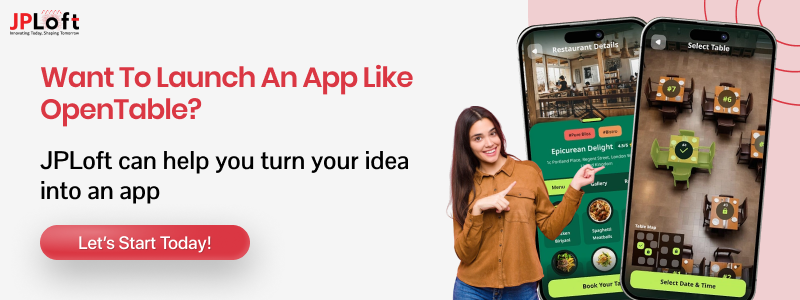
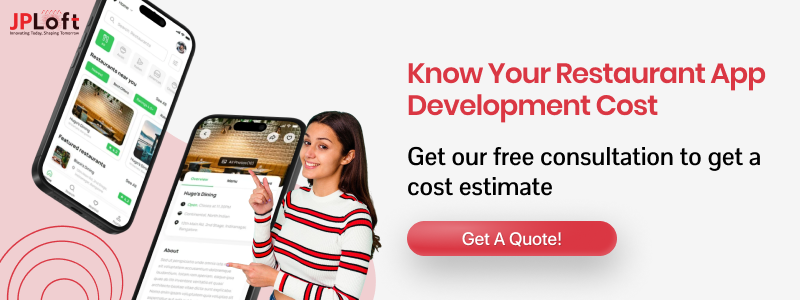

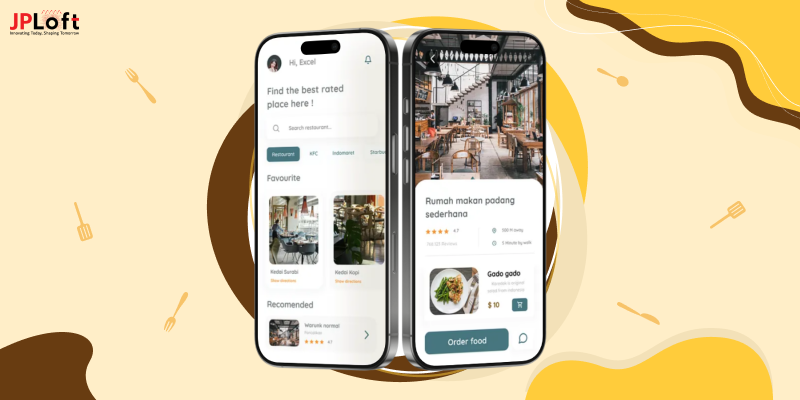
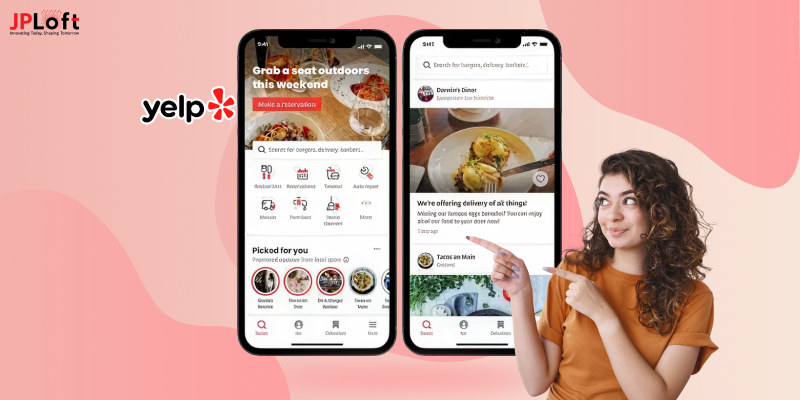



Share this blog